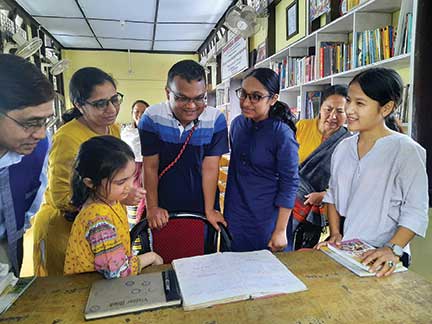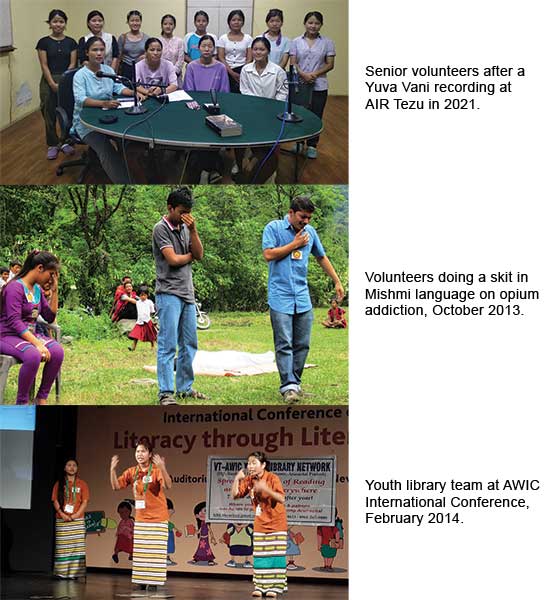Jeenamsi Ngadong
with Keselo Tayang, Anjangmai Mam, Bethem Marai and Solina Kambrai
“‘Library’ – the word might create an impression of a boring, quiet place with dusty books. However in June 2007, as a 10-year-old student in the mountains, I didn’t even have that image, because like the other schools in our small town, we had no library, and books to us meant only textbooks. Yet, only in a few years, I would not only discover the wonder that the word is, but also become an ardent library-activist travelling from Delhi to Kaho, the last village on the China border spreading the ‘Joy of reading,’” says Abhinav Dwivedi, a medical student now in UP, and one among the young volunteers who grew up with the joy of reading movement in Arunachal Pradesh.

This is the story of the Lohit Youth libraries, which stirred up a gentle socio-educational wave across Arunachal Pradesh and has now won national awards and recognition, including a Padma Shri for our founder-coordinator! We, among the senior-most group of activists of the movement, would like to share a brief account of this evolution. All of us are first generation girl-students from the Mishmi tribal community.
Why was a youth library movement needed in Arunachal?
Arunachal has 26 major tribal communities, each with its own language, and around 100 dialects, none of which has a script and are mostly unintelligible. In 1972, English became the medium of instruction in schools. But Hindi remains the lingua-franca! It is only recently that the government has started encouraging communities to develop scripts for our languages and prepare textbooks for teaching in Arunachali languages.
Uncle Moosa, the founder-coordinator of the Lohit Youth Library Network, who has spent over four decades working with Arunachali youth, lists the obstacles in developing a reading culture among the youth here:
“Himalayan States like Arunachal have multiple challenges: thinly populated and scattered villages, poor road connectivity, lack of infrastructure like power supply, limited access to schools, reading resources and internet services, etc. After the introduction of Sarva Siksha Abhiyan (SSA) in 2002, there was a complete change in our school system. SSA stressed on more schools in villages, overlooking the aspect of whether a school could be viable in such remote areas. Thus most government residential schools were closed and a string of ill-equipped day-scholar government schools and private residential schools sprung up across the state. As expected, there was a dearth of adequate teachers proficient in English, willing to work in remote schools.
My long association with Arunachali students made me realize that the only way to counter such an adverse learning environment, is to somehow find innovative ways to build a learning culture. That’s how the youth library movement was born in 2014.”
How the youth library movement grew
Fortunately, many enlightened administrators came to our support, like our founder-patron Prashant Lokhande, a senior IAS officer. Our movement now comprises volunteers, well-wishers, teachers, parents and patrons across the country, and even abroad, with the local government agencies. Generally, in rural areas, girls’ education usually suffers. We are very fortunate that most of the volunteers of the Lohit Youth library network have been girls. Through them, parents could understand the importance of reading and how reading can transform the lives of rural tribal girls.

Salient features of the Lohit youth library network:1
Our youth library movement is entirely different from similar initiatives. Here is why:
- All members work on their own without any compulsion or remuneration.
- Decentralized network with no central authority. Each library is independent and works as per the local situation. As Uncle Moosa likes to say, “The coordinator does not run the movement. He runs with the movement!”
- Our well-wishers – engineers, doctors, writers, environmentalists, theatre artists, film makers2 and even senior IAS officers, support us with time, money, resources, and technical knowledge.
- We target the reading-deprived by conducting reading campaigns in the remotest of villages!
- Even though our languages don’t have scripts, we try to create a literary environment through skits3 and radio talks5 in our languages.

Reading campaigns – how and why? – Keselo Tayang, an ace storyteller answers.
‘When children can’t reach the books, the books should reach the children!’ That’s our motto! Hence reading campaigns became our USP. We do poetry, drama, and storytelling sessions and train readers. Campaigns also include mini-book exhibitions and awareness sessions4 on environmental, literary, and social issues such as opium addiction.
When libraries can’t reach readers in tiny villages… Anjangmai Mam, a dedicated volunteer, points a way forward
For our thinly scattered population, a normal library system is not suitable. So we felt, why not let our volunteers set up a ‘vacation mini-library’ in their villages? Now we have 10 mini vacation libraries running for the last 10 years! Two of these mini-libraries have grown into full-fledged ones, like the Medo Youth Library, with support from our patrons.
Have youth libraries helped us in our education and life? Our team mate Bethem Marai answers…
I come from a remote village where there is no proper schooling, electricity, or internet. Being a first generation learner, I had reached 6th standard but was not able to read. APNE Library gave me a different view of learning. I started taking part in library programmes and there was no looking back.

We got many unique opportunities: Our senior volunteer Keselo Tayang got a chance to meet Dr.APJ Abdul Kalam in 2010, when she was just in 5th standard! Many of us could publish articles and short stories in various magazines. We hadn’t even reached class 10 when our own writings came out as an anthology called “Mishmi Land Musings”!
Youth library movement – what is its future? Solina Kambrai shares her thoughts…
The library movement’s main objective is to promote the joy of reading among the youth6. Once trained, the youth themselves become ‘activists’ and pass the joy onto others, creating new readers and volunteers.
Swami Vivekananda says, “All the wealth in the world cannot help a little Indian village, if people are not taught to help themselves”. Our movement espouses this philosophy and can be a model not only for Arunachal but the entire nation.
References
- Library Network’s website: www.lohit-libraries.org
- Joy of Learning – A docu-film by P.N. Ramchandra (2017) on Lohit Youth Library Network. https://youtu.be/6SQAKEI-1vM
- Skits: “Kayum Saa” (The Black Boy) – a skit in Mishmi language on George Washington Carver (2019), https://bit.ly/3AUwbd6
Skit on Anutai Wagh, http://youtu.be/CtqOdMMdEB8 - Sanjay Sondhi, Terragreen Aug 2012 ‘Wild Wonders’: https://bit.ly/3Q6DToR
- Yuva Vani – AIR Tezu on International Mother Langauge Day Feb 19, 2021. https://bit.ly/3wvQhZa
Yuva Vani show AIR Tezu on International Literacy Day Sep 9, 2021. https://youtu.be/jtKp56JRq3Q - Joy of reading Newsletters 2021 & 2022.
A round up of activities of Lohit Youth Library Network 2020-21. https://bit.ly/3qxmnQp
A round up of activities of Lohit Youth Library Network 2021-22. https://bit.ly/3AHPvdw
Additional references
- “Could reading be such fun?”: S. Mundayoor – An article by in the ‘Anthology of papers on English Language Teacher Education & Development’ (British Council, Chennai, 2011). https://bit.ly/36VnFxT
- “A Hilly Trail of Books”: Nabanita Deshmukh, Teacher Plus, Nov 2017: an article by on 10 years of the Lohit Youth Library Movement. https://bit.ly/3uydQhA
- “A Fairy Tale Story in Arunachal”: Sreedevi P. Teacher Plus, Aug 2009. https://bit.ly/3Ain8RC
- “Renaissance of Reading”: Ninan P Thomas, Apr 2018: A study on Lohit Youth Library Movement – a PG dissertation@ the Tata Institute of Social Sciences, Guwahati, India. https://bit.ly/3JRe6i9
Jeenamsi Ngadong and her group are first generation tribal girls from Wakro circle in eastern Arunachal Pradesh, who have emerged themselves as senior youth library volunteers & reader-activists, with over a decade of reading campaign experiences. They have done their post graduation from Coimbatore, except Bethem Marai, who did her post graduation in Social Work from Itanagar. Jeenamsi, an MA in English is keenly interested in books and loves training students in poem recitation. Keselo is an ace story teller and an expert trainer of adolescents. Bethem, a caring mentor of readers at youth libraries, is a dynamic speaker and vlogger. Anjangmai loves training young readers in poem recitation and book reading skills. Solina, an M.Sc Botany, is a gifted dancer and participates frequently in reading campaigns.
